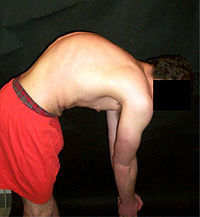
Photo from wikipedia
Congenital scoliosis (CS) is a spinal deformity resulting from underlying spinal malformations with an incidence of 0.5–1/1000 births. CS makes up 10% of scoliotic deformities, of which 25% do not… Click to show full abstract
Congenital scoliosis (CS) is a spinal deformity resulting from underlying spinal malformations with an incidence of 0.5–1/1000 births. CS makes up 10% of scoliotic deformities, of which 25% do not progress, 25% progress mildly and 50% need treatment depending on the age, curve characteristics and magnitude and type of anomaly. CS is associated with non-vertebral anomalies (genitourinary, musculoskeletal, cardiac, ribs anomalies, etc.) and intraspinal anomalies (syrinx and tethered cord). Imaging should include whole spine X-rays, CT scanner with reconstruction to better delineate the vertebral anomalies and MRI to visualize the neural elements. Treatment of CS in the majority of cases is non-surgical and relies on fusion techniques (in situ fusion and hemiepiphysiodeis), resection techniques (hemiverterba resection), and growth-friendly techniques (distraction and instrumentation without fusion).
Journal Title: EFORT Open Reviews
Year Published: 2022
Link to full text (if available)
Share on Social Media: Sign Up to like & get
recommendations!